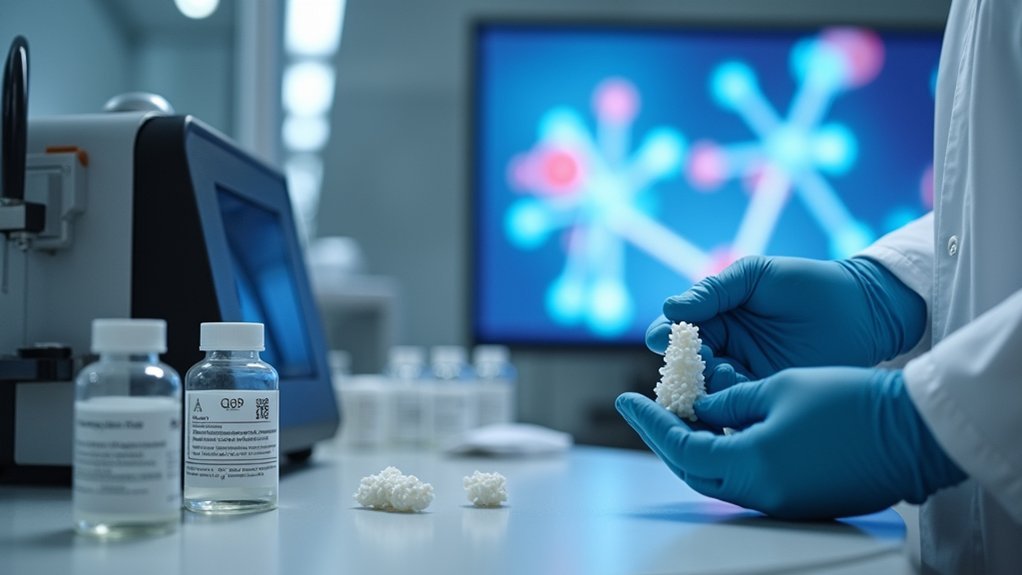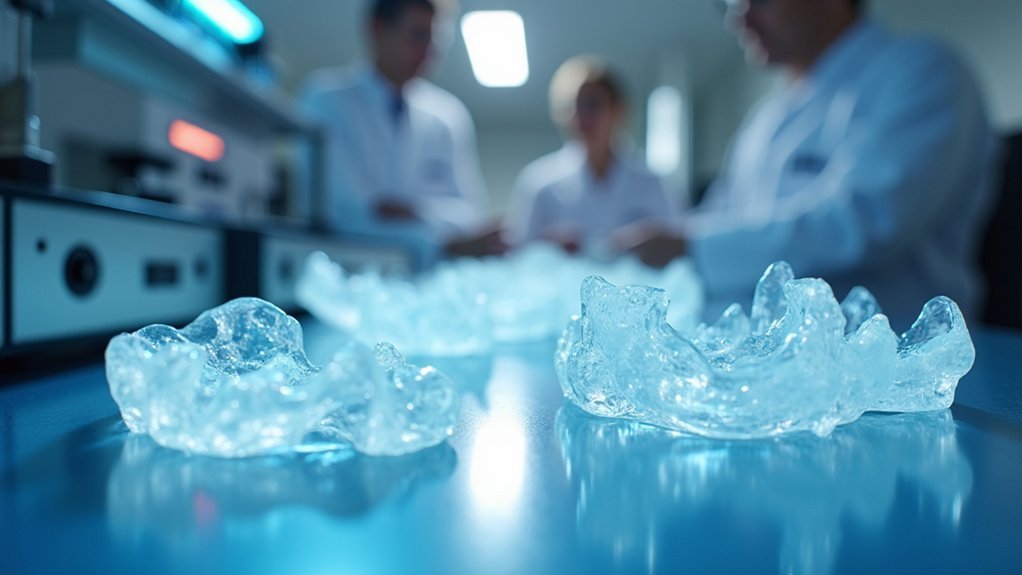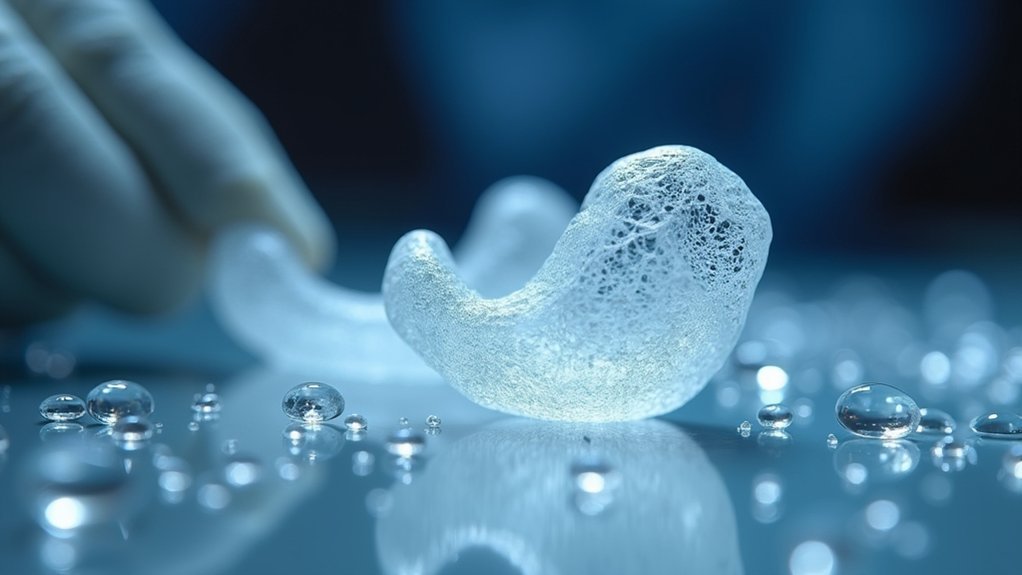You should choose biocompatible resins for medical 3D printing because they meet stringent ISO 10993 standards and FDA requirements, ensuring patient safety through non-toxic, non-sensitizing formulations. These materials enable you to create patient-specific devices like surgical guides, dental aligners, and custom prosthetics with superior precision that’s impossible through traditional manufacturing. They withstand sterilization procedures while maintaining dimensional accuracy and mechanical strength. Continue exploring how these advanced materials are revolutionizing personalized healthcare solutions.
Understanding Biocompatible Resin Standards and Regulatory Requirements

When developing medical applications with 3D-printed resins, you’ll need to navigate a complex landscape of biocompatibility standards that govern material safety and regulatory approval. The ISO 10993 series serves as your primary framework, with key sections including ISO 10993-5 for cytotoxicity testing, ISO 10993-10 for sensitization and irritation assessment, and ISO 10993-23 for device-specific materials testing.
You’ll find that regulatory bodies like the FDA and EMA require rigorous compliance documentation before you can market medical-grade resins. This includes biological risk assessments, chemical characterization, and mechanical safety evaluations.
Don’t overlook post-processing validation—your washing, curing, and sterilization protocols must maintain the material’s biocompatibility. Manufacturers typically specify which ISO 10993 subsections they’ve tested, helping you select appropriate materials for your specific applications. If you encounter complex regulatory questions, dedicated customer support teams from resin manufacturers can provide valuable guidance throughout the approval process.
Key Medical Applications and Use Cases for Biocompatible Resins
As biocompatible resins meet rigorous safety standards, you’ll discover their transformative impact across diverse medical applications where precision, customization, and patient safety converge.
You can create patient-specific anatomical models from medical scans for surgical planning, enabling surgeons to visualize complex anatomies and reduce operative times.
Patient-specific anatomical models from medical scans enable surgeons to visualize complex anatomies and significantly reduce operative times.
In dentistry, you’ll fabricate custom aligners, crowns, and surgical guides with exceptional accuracy using SLA and DLP technologies.
For hearing aids and wearable devices, these resins provide comfortable, skin-safe shells with variable mechanical properties.
In orthopedics, you can print artificial bone scaffolds and customized prosthetics that integrate seamlessly with patient anatomy.
For cardiovascular applications, you’ll utilize biodegradable bioresins for cardiovascular stents that degrade and are absorbed by the body over time.
Additionally, you’ll rapidly prototype disposable surgical tools, revolutionizing medical device manufacturing through enhanced customization capabilities.
Material Properties and Types of Medical-Grade Printing Resins

The success of these medical applications depends heavily on selecting resins with the right material properties and biocompatibility classifications for your specific use case.
You’ll find Class I biocompatible resins perfect for sterilized surgical devices requiring direct patient contact, while Class IIa resins suit long-term applications like dental devices used up to one year.
BioMed Clear Resin offers transparency and wear resistance for precision surgical guides, whereas Dental Long-Term Biocompatible Resin provides fracture resistance for orthodontic applications.
These materials withstand autoclave sterilization at temperatures up to 134°C without degradation.
You’ll benefit from their non-cytotoxic, non-sensitizing formulations that comply with ISO 10993 standards, ensuring smooth surface finishes that minimize contamination risks in clinical environments. The strict Quality Management Systems ensure consistent material integrity and safety throughout the manufacturing process.
Advantages of Biocompatible Resins Over Traditional Manufacturing Materials
When you’re comparing biocompatible resins to traditional manufacturing materials, you’ll immediately notice their superior ability to create patient-specific medical devices that perfectly match individual anatomical requirements.
You can’t achieve the same level of intricate customization with conventional methods like machining or molding, which are limited by tooling constraints and geometric complexity.
You’ll also find that these resins offer markedly improved safety profiles through rigorous FDA qualification processes and enhanced biocompatibility that reduces risks of adverse reactions in patients. The precision and durability of modern biocompatible resins make them particularly beneficial for personalized medical treatments that require exact specifications.
Enhanced Customization Capabilities
While traditional manufacturing methods constrain designers to simplified geometries, biocompatible resins reveal unprecedented customization capabilities that revolutionize patient-specific medical device production.
You’ll create intricate internal structures, undercuts, and micro-scale details that machining can’t achieve. These resins let you tailor mechanical properties from rigid implants to flexible wearables, matching your patient’s exact anatomical requirements.
You’ll fabricate prosthetics that mimic natural limb function while conforming perfectly to unique body contours. Custom surgical guides enhance procedural accuracy, and you can integrate specialized coatings like silver ions or hydroxyapatite directly into designs.
This flexibility eliminates the expensive tooling traditional methods require, making single-unit production economically viable. You’re no longer limited by manufacturing constraints—instead, you’ll optimize every design element for individual patient anatomy and clinical needs. These materials must comply with ISO 10993 standards to ensure they’re safe for long-term contact with living tissue.
Improved Safety Profiles
Beyond customization advantages, biocompatible resins deliver markedly enhanced safety profiles that surpass traditional manufacturing materials in medical applications.
You’ll benefit from materials that comply with ISO 10993-1 standards and undergo rigorous certification testing for toxicity, irritation, and sensitization. These resins eliminate harmful compounds like BPA and organo-tin while minimizing volatile organic compounds that could compromise patient safety.
You can trust that proper post-processing removes residual uncured resin, preventing inflammatory or allergic responses when devices contact skin or internal tissues. These advanced formulations are specifically designed for biomedical applications across multiple medical device classes, ensuring compatibility with varying safety requirements.
The resins withstand standard sterilization procedures—autoclaving, gamma radiation, and ethylene oxide—without degrading or forming toxic byproducts. This durability guarantees your medical devices maintain their safety properties through repeated sterilization cycles, meeting regulatory standards for clinical use.
Performance Testing and Reliability Factors for Medical Applications

When you’re implementing biocompatible resins in medical applications, you’ll need to validate their safety through thorough post-printing biocompatibility testing that confirms the material maintains its non-toxic properties after processing.
You must also conduct long-term durability assessments to guarantee your printed devices can withstand physiological conditions throughout their intended lifespan without degrading or failing.
Additionally, you’ll have to meet strict regulatory compliance standards like ISO 10993 and FDA requirements to demonstrate that your biocompatible resin products are safe and effective for clinical use. Your device classification will determine the specific testing requirements, as Class I devices need only a technical file while Class III devices require a full quality assurance system audit.
Post-Printing Biocompatibility Validation
Once you’ve completed the 3D printing process, rigorous biocompatibility validation becomes essential to confirm your medical devices meet safety standards and perform reliably in clinical settings.
You’ll need to conduct cytotoxicity testing using human gingival fibroblasts or relevant cell lines to ascertain your printed parts don’t release toxic substances that harm cells.
Chemical characterization identifies residual monomers and degradation products that could pose patient risks.
You must also verify sterilization compatibility through gamma radiation, EtO, or hydrogen peroxide gas plasma methods without compromising material integrity.
Additionally, you’ll perform mechanical testing to confirm that sterilization processes don’t degrade your device’s tensile, flexural, or heat deflection properties, assuring sustained performance throughout clinical use.
Test coupons should be placed on the build plate during printing to validate the integrity and consistency of your medical device production, ensuring reproducible results across manufacturing batches.
Long-Term Durability Assessment
While biocompatibility validation confirms your printed devices won’t harm patients initially, long-term durability assessment determines whether they’ll maintain their structural integrity, mechanical properties, and safety profile throughout extended clinical use.
You’ll need to evaluate mechanical strength retention after repeated sterilization cycles using EtO, electron beam, or gamma irradiation. Your biocompatible resins must resist degradation from hospital disinfectants and bodily fluids while maintaining dimensional accuracy under operational temperatures and moisture exposure.
Fatigue testing reveals how your devices perform under repetitive mechanical stresses, particularly vital for implants experiencing biomechanical loads. Materials must demonstrate positive host response to ensure successful integration and minimize adverse biological reactions over time.
High-quality biocompatible resins like BioMed Durable demonstrate tensile strengths around 29.1 MPa with excellent impact resistance, ensuring your medical components won’t fail during critical applications.
Regulatory Compliance Standards
Before you can bring your 3D-printed medical devices to market, you must navigate a complex regulatory landscape that demands rigorous performance testing and thorough documentation.
You’ll need to demonstrate biocompatibility through ISO 10993-1 standards, conducting cytotoxicity assays and in vivo tests to prove your resin won’t cause harmful biological responses.
Your resin’s classification determines whether you’ll pursue FDA 510(k) clearance or qualify for exemptions based on risk level and intended use.
You must validate mechanical properties like strength and flexibility, guarantee dimensional accuracy meets medical specifications, and confirm your prints withstand sterilization processes.
Documentation of regulatory clearance becomes essential for your supply chain and quality assurance protocols in clinical environments. Regulatory requirements can vary significantly between geographic locations, with the EU Medical Device Regulations presenting different compliance standards than FDA protocols in the United States.
Impact on Healthcare Innovation and Personalized Medicine Development
As biocompatible resins transform medical 3D printing capabilities, they’re reshaping healthcare innovation by enabling unprecedented levels of personalization in patient treatment.
You can now create implants precisely tailored to individual anatomical needs, reducing rejection risks and improving integration with human tissues. These materials let you develop custom drug delivery systems with patient-specific dosages and release profiles, enhancing medication adherence for chronic conditions like diabetes.
You’re witnessing breakthroughs in tissue engineering where biocompatible resins serve as scaffolding for 3D bioprinting patient-derived cells into functional tissues.
This technology reduces transplant dependency while advancing regenerative medicine. The innovation democratizes healthcare by lowering barriers for complex medical device production, fostering collaboration between clinicians, researchers, and manufacturers to co-develop novel therapies. Biocompatible resins enable the creation of patient-specific anatomical models that enhance surgical precision and improve overall patient outcomes during complex procedures.
Frequently Asked Questions
How Much Do Biocompatible Resins Cost Compared to Standard 3D Printing Materials?
You’ll pay considerably more for biocompatible resins, typically $199-$300+ per liter compared to standard resins at $15-$150. That’s roughly double the cost, but you’re getting medical-grade certifications and safety.
What Is the Typical Shelf Life of Unopened Biocompatible Resin Bottles?
You’ll find unopened biocompatible resin bottles typically last 6-24 months, depending on the type. Dental-grade resins often reach 18-24 months, while conductive varieties may only last 6 months at room temperature.
Can Biocompatible Resins Be Recycled or Reused After Failed Prints?
You can’t effectively recycle biocompatible resins after failed prints. They lose certification, change properties, and pose contamination risks. Most manufacturers recommend discarding failed batches to maintain medical-grade safety standards.
Which 3D Printer Brands Are Compatible With Medical-Grade Biocompatible Resins?
You’ll find that professional printer brands like Asiga and atum3D support medical-grade biocompatible resins, while entry-level options including Phrozen, Elegoo, Creality, and Anycubic also offer compatibility for accessible medical printing.
How Long Does Post-Processing Take for Biocompatible Resin Printed Parts?
You’ll spend about 4-5 minutes washing parts twice with IPA, then wait 60 minutes for drying. Post-curing takes approximately 30 minutes at 60°C, totaling roughly 90-95 minutes for complete processing.





Leave a Reply